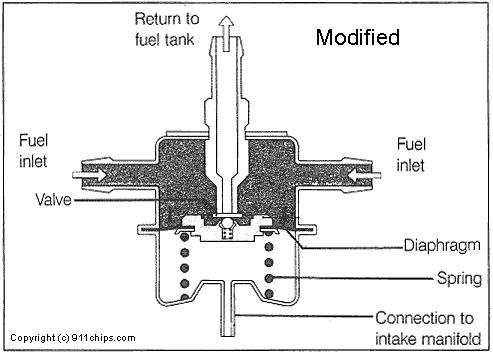Fuel
pressure in the fuel system is held at a constant
differential pressure relative to the pressure/vacuum
in the intake manifold. This insures that no
matter what the vacuum (boost in the case of turbos) levels
are in the intake manifold, the fuel injectors
sees the same relative pressure and injects the
same amount of fuel regardless of the manifold
pressure. The intake manifold connects to the
regulator via a plastic/rubber vacuum line from
the throttle body to the nipple on the regulator,
placing either vacuum or boost pressure on the
spring loaded diaphragm, controlling the release
pressure of excess fuel back to the fuel tank.
The regulator's release pressure is controlled
by the preset load on the internal spring as shown
in the diagram. Adjustable fuel pressure regulators
operate in the same principle, except that the
preload on the spring is adjustable.
On
a Carrera 3.2, 250 hp begins to be about the limit
at the stock pressure until the fuel injectors
start to run out of duty cycle. For highly modified
engines, raising the fuel pressure to 3 bar increases
the max fuel deliverable from the factory injectors
by about 10%. An additional benefit is that forcing
the fuel through the same injector at a higher
pressure improves fuel atomization. However, you
don't need an adjustable regulator to alter the
system fuel pressure. You can actually alter
the fuel pressure of the factory regulator to
your specifications.
The
animation below displays the stock pressure regulator
modified to produce additional fuel pressure.
By compressing the shell of the regulator slightly,
additional pressure is placed on the internal
spring, which effectively raises the release fuel
pressure. To properly compress the regulator and
calibrate the release fuel pressure, place the
body of the regulator between a hand operated
press with two large nuts on the body of each
end to protect the vacuum nipple and return port,
and compress very slightly. Connect a compressed
air line or bicycle pump with an accurate pressure
gauge to one end of the fuel inlet, and cap off
the other inlet. Apply a small amount of pressurized
air to the inlet and measure the release air pressure
on the gauge - this is the fuel release pressure.
With a stock regulator, you will measure approximately
37 psi before excess air starts blowing out the
return port. As you compress the body, and test
the release pressure, you will actually measure
a rise in pressure retained. Stop when the desired
pressure is attained.
This
modification is only illustrated for those owners
who have already so determined that increased
fuel pressure is necessary for their modifications.
The vast majority of owners do not need and should
not perform this modification as the stock fuel
injectors are more than capable of delivering
enough fuel for the majority of engine modifications.

